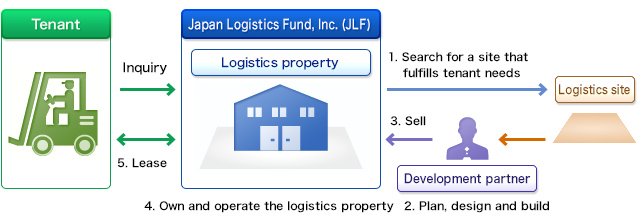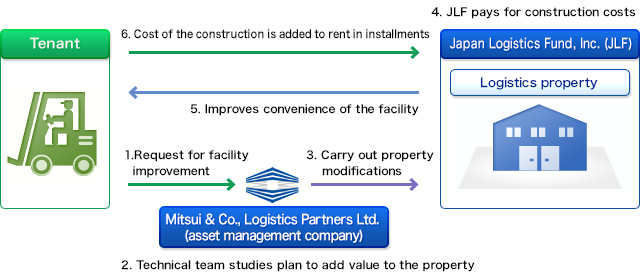We are a “landlord” of logistics properties.
Japan Logistics Fund, Inc. (JLF) is Japan’s first dedicated logistics REIT. JLF is structured like many other Japan REITs (J-REITs), which invest money gathered from investors in real estate assets like office buildings and residential buildings. However, the assets JLF owns and leases are exclusively logistics properties.
JLF owns many logistics properties located primarily in the Tokyo Metropolitan Area. As a dedicated logistics REIT, we plan to leverage our discerning eye for logistics properties as a pioneer and continue invest in prime assets.
By building relationships of trust with the tenants who use the logistics properties owned by JLF, we look forward to contributing to the development of the logistics industry as a whole.
Choosing Logistics Space for Lease
The cargo owners and logistics service providers who use logistics properties face many high-yielding investment alternatives. For example, investments in developing services in their core business, cultivating talented employees, IT systems or business expansions through mergers and acquisitions could generate higher returns than money spent to own a logistics facility. Leveraging the leased logistics space we offer through JLF enables these companies to focus limited management resources on their core businesses.
Moreover, because we focus on leasing space and do not provide cargo-handling services, cargo owners view JLF as an alternative to the traditional model offered by third-party owners and operators of logistics properties. At the same time, JLF supports the business models of third-party logistics providers who seek to leverage logistics space owned by JLF to deploy logistics solutions to cargo owners.

Example 1: Development Project
Leveraging the expansive network we and our sponsors possess, we search for a logistics site that fulfills tenant needs, JLF acquires a logistics facility developed on the site by our development partner and leased the space within. The specs of the building are essentially highly versatile. However, depending on the term of the lease and rent price, tenant improvements can also be considered.

Example 2: Sale and Lease Back
In this case, JLF buys an existing logistics property and leases it back to the seller. The seller can continue to use the logistics property and leverage the proceeds from the sale to make new investments or paid down debt. Re-building is another option. If the building is obsolete, it can be sold to JLF. JLF would then scrap the existing facility and build a new one for lease.

Example 3: Enhancing the Value of a Currently Owned Property
In this case, JLF makes modifications to an actively occupied property that JLF owns to suit tenant needs and enhance the convenience of the property. JLF does the construction work and incorporates the cost of the construction into the tenant’s rent over multiple installments. Because JLF bears the upfront cost of work aimed at adding value to the property, this lightens the burden on the tenant.








